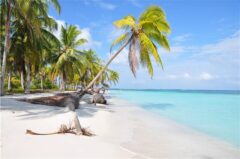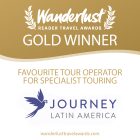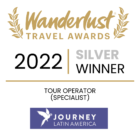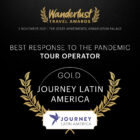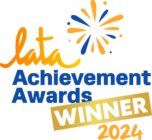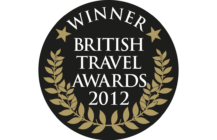Group - Discovery
Tanager: Flora and fauna of Costa Rica
12 days from £3,415pp
(based on two people sharing & excluding flights)
Itinerary
 Map
Map
Day 1
Fly into San José and transfer to hotel.
You will be met at the airport by your tour leader or one of our other local representatives who will take you to your hotel in the capital.
Day 2
Drive and boat to Tortuguero Jungle Reserve.
Today we head off to discover the Caribbean coast with a few days of rewarding wildlife spotting. This is true wilderness: it isn’t the Caribbean of resort hotels, sugary beaches and piña coladas. The road strikes out northeast through Braulio Camillo National Park, including a short bumpy ride through banana plantations to La Pavona dock.
Then it’s a boat ride along the shore hugged by twisted mangrove swamps before we arrive in the small, ramshackle and remote village of Tortuguero. Getting there is part of the adventure: it could take between two and four hours depending on how often we stop to observe plants or wildlife.
Of course one of the area’s biggest draws is the proliferation of turtles (nesting Jul-Oct) and you will learn about projects to conserve and protect these magnificent creatures.

Day 3
Guided exploration of the reserve by boat.
We’ll set off on a wildlife adventure with a boat trip through the mangrove forest of Tortuguero National Park, now one of the last protected areas of tropical rainforest in Central America, with 11 different natural habitats and a huge range of endemic wildlife, much of which can be spotted as you glide through the water.
There are three species of monkeys (spider, howler, and white-faced) which you may spot swinging from branch to branch while lazier three-toed sloths doze in the shade and river otters pop up in the natural inland channels. Caimans, iguanas, river turtles, lizards and poison dart frogs also populate the mangroves, along with over 320 species of birds including three of toucan and eight of parrot: we are sure to spot a good number of them.

Day 4
By boat and road to Sarapiquí.
We’re back on the water to explore more of these spidery channels on the way back to the dock followed by a drive to the Sarapiquí region, a fertile plain where jungle was cleared for cattle ranches but which is now a focus for conservation with a number of eco-tourism projects.
There are forested national parks in the area, dispersed between banana and pineapple plantations. Rio Sarapiquí is becoming popular for rafting on its rapids and bird-watching and numerous other activities in the area include mountain-biking, boat trips and canopying.

Day 5
Visit La Tirimbina Rainforest Reserve.
The morning we’ll take a natural history walk in the Tirimbina Reserve, which caters for research and recreation in a rainforest environment. The reserve was founded to preserve one of the few remaining stands of intact tropical forest on mountainous slopes in Central America, and, through education, to incorporate the participation of local communities.
To make exploration even more varied, there’s a suspension bridge, canopy walkway and rainforest museum in the reserve. Once again, a variety of mammals and insects can be spotted, and we may come across a few nocturnal animals, fast asleep in the heat of the day.
Day 6
Drive to Bijagua.
The town of Bijagua sits on a saddle between two volcanoes, Tenorio and Miravalles and is the base for visits to Tenorio Volcano National Park, established in 1997 to protect tracts of primary and dry tropical forest. Trails within the park are still being created, and it’s regarded as one of the new up and coming destinations for nature lovers and adventure seekers.
Bijagua itself is a peaceful spot where the inhabitants’ income drives from small scale crop farming and cattle pastures. There are a number of facilities including a school and others we may find useful, including a bank, pharmacy and shops.
If there’s time during our couple of days here, you may like to explore the area’s trails on horseback or mountain bike.

Day 7
Visit Rio Celeste and Tenorio Volcano National Park.
Those of us who up for a moderately challenging 6km hike will set of for Rio Celeste, remarkable for its striking turquoise blue colour. While walking along the trail we’ll keep an eye out for monkeys, sloths, tropical birds and other wildlife, while enjoying views of hot springs and a lagoon. The winding path follows the banks of the river, taking us upstream while the vivid blue colour of the water deepens until we arrive at a photogenic waterfall.

Day 8
Drive to Monteverde.
Head on by road to Monteverde. The last section of the road is where the adventure begins – we follow a dirt road bumpy with volcanic rocks, winding up through the hills to the cloud forest at 1,400m above sea level. We can expect it to be dusty in the dry season and muddy in the wet. However we should be diverted by wildlife we spot along the way – sloths, monkeys and tropical birds – keep your binoculars handy.
We’ll be staying in a lodge close to the village of Santa Elena, as unassuming settlement which is nevertheless the hub for visits to the Monteverde National Park and enlivened by a few craft shops and restaurants.

Day 9
Explore Selvatura Park and Monteverde Cloudforest Reserve.
Selvatura Park is a conservation area offering a number of exhilarating activities including zip lines. We’ll take a walk over its trail system which includes seven suspension bridges crossing the deep canyons at treetop level.
In the afternoon we have a guided walk in the Monteverde Cloudforest Reserve, home to more than 100 species of mammals, 400 of birds and 1,500 of plants. We follow the well-marked trails, amidst dense, mist-shrouded, dripping foliage – with luck we’ll encounter the iconic bird, the brilliantly feathered resplendent quetzal (Jan – Jul). Other striking species include the emerald toucanet and we should also be able to spot white-faced and howler monkeys. The reserve embraces a protected area with six different life zones: so many habitats in such a small area allow us to enjoy a rich diversity of flora and fauna within a short distance and by easy walking.

Day 10
Carara National Park.
Today we set off on a journey down towards the Pacific coast, and enter a completely different vegetation zone of Pacific tropical dry forest.
Carara is a popular national park famous for its bright scarlet macaws and giant crocodiles, which sprawl on the beaches of the Tarcoles river – we’ll view them safely from a bridge! Upon arrival at Finca Ecologica La Trinidad we’ll do something a bit different, with a cookery lesson on the premesis. There’s also time for an optional (extra cost) ride on horseback.

Day 11
Day at leisure.
Today you can rest up at the lodge, which is situated next to the Carara National Park itself. It’s a good base from which to go bird-watching – the forest is less dense here than in the other parks we have visited, making it easier to spot the wildlife – or set off on one of the marked hiking trails. Alternatively, just drink in the panoramic views from the lodge over the forests, river and ocean.

Day 12
Transfer to San José airport for international flight.
Today you’ll be flying home, unless to decide to stay on for a few more days in this beguiling country, perhaps for some beach time at Manuel Antonio where there’s a range of good accommodation, a monkey-filled national park and sweeping golden Pacific sands.
UK clients arrive home the following day.
Outline itinerary
Day 1
Fly into San José and transfer to hotel.
Day 2
Drive and boat to Tortuguero Jungle Reserve.
Day 3
Guided exploration of the reserve by boat.
Day 4
By boat and road to Sarapiquí.
Day 5
Visit La Tirimbina Rainforest Reserve.
Day 6
Drive to Bijagua.
Day 7
Visit Rio Celeste and Tenorio Volcano National Park.
Day 8
Drive to Monteverde.
Day 9
Explore Selvatura Park and Monteverde Cloudforest Reserve.
Day 10
Carara National Park.
Day 11
Day at leisure.
Day 12
Transfer to San José airport for international flight.
UK clients arrive home the following day.
Inspired by this trip
Our exciting range of articles on Latin America explore everything from iconic destinations and lesser-known cultural gems to delicious traditional recipes. You’ll also find exclusive travel tips, first-hand client reviews and the chance to get your personal questions answered by our travel experts.
Papagaio
Your edit for Latin American inspiration
Our exciting range of articles on Latin America explore everything from iconic destinations and lesser-known cultural gems to delicious traditional recipes. You’ll also find exclusive travel tips, first-hand client reviews and the chance to get your personal questions answered by our travel experts.
View Extraordinary Inspiration
